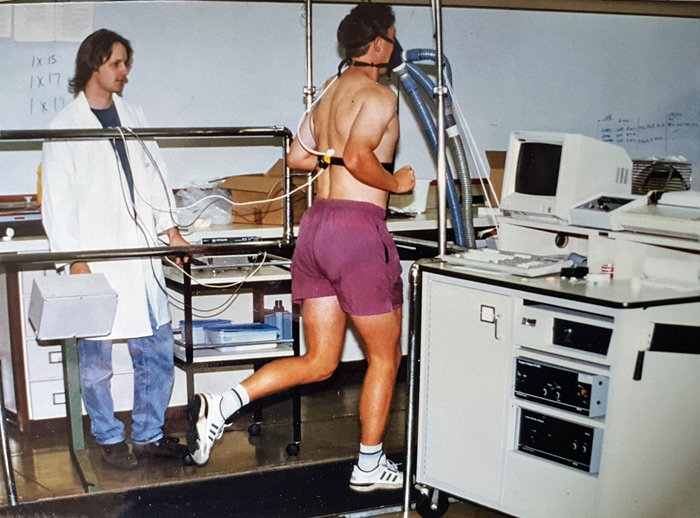The VO2max test is the criterion measure of aerobic power in athletes. Described here is the method to measure VO2max directly by indirect calorimetry.
equipment required: Oxygen and carbon dioxide analyzers, heart rate monitor (optional) and a stopwatch. Appropriate ergometer (treadmill, cycle, swim bench etc.). Expired air may be collected and volume measured via Douglas bags or a Tissot tank, or measured by a pnuemotach or turbine ventilometer.
pre-test: Explain the test procedures to the subject. Perform screening of health risks and obtain informed consent. Prepare forms and record basic information such as age, height, body weight, gender, test conditions. Check and calibrate the ergometer. Subject to perform an appropriate warm-up. See more details of pre-test procedures.
procedure: Exercise is performed on an ergometer, ideally one which is appropriate to the sport or a familiar exercise mode of the subject. The exercise workloads are selected to gradually progress in increments from moderate to maximal intensity (see cycling protocols). Oxygen uptake is calculated from measures of ventilation and the oxygen and carbon dioxide in the expired air, and the maximal level is determined at or near test completion (see Measuring Oxygen Consumption by Indirect Calorimetry)
scoring: Results are presented as either l/min (liters per minute) or ml/kg/min (mls of oxygen per kilogram of body weight per minute). The athlete is considered to have reached their VO2max
if several of the following occurred: a plateau or 'peaking over' in oxygen uptake, maximal heart rate was reached, attainment of a respiratory exchange ratio of 1.15 or greater, and volitional exhaustion. See also the Adult VO2max norm values.
 VO2max treadmill test
VO2max treadmill testwhat exercise mode is best? A VO2max test can be performed using any exercise mode, though most commonly a treadmill or cycle ergometer is used. A treadmill VO2max test has the advantage as running involves whole body exercise and is more likely to elicit a higher VO2max . However, the stable base of testing VO2max on a cycle ergometer provides less movement and it is therefore easier for accurate gas collection, measurement of heart rate and RPE. It is also possible to use swimming exercise and arm-cranking. Using the most specific exercise mode for the athlete and the sport involved is usually the best option.
variations / alternatives: The Vmax test is essentially a VO2max test without the gas analysis, with some similar results. Many other aerobic fitness tests estimate VO2max scores from their results. See the other tests of Aerobic Endurance.
target population: Any sport in which aerobic endurance is a component, such as distance runners, cross-country skiers, rowers, triathlon, cycling.
advantages: This test directly measures body oxygen consumption, which many other aerobic fitness tests try to estimate. You can also get a direct measurement of maximum heart rate by recording heart rate during the test.
disadvantages: this test is relatively time consuming and has high costs involved for each test compared to many other aerobic fitness tests.
comments: There is often variability between the performance of different analysis systems. Stringent calibration is necessary for both the expired gas and ventilation measurement systems.
caution: This test is a maximal test, which requires a reasonable level of fitness. It is not recommended for recreational athletes or people with health problems, injuries or low fitness levels.
Similar Tests
- Treadmill VO2max Test - a maximal exercise test to measure VO2max while running on a treadmill.
- Cycling Maximal Oxygen Consumption Test (VO2max) — a maximal exercise test to measure VO2max while riding a cycle ergometer.
- Swimming VO2max Test
Related Pages
- Videos of VO2max Tests being performed.
- Formula for estimating VO2
- There are also other tests of aerobic capacity, such as the Bruce Test.
- Measuring Basal Metabolic Rate — VO2 at rest.
- About the respiratory exchange ratio (RER)
- Methods for heart rate measurement, if heart rate measurement is also required.
- Measuring Oxygen Consumption by Indirect Calorimetry
- Ratings of Perceived Exertion Scale if you want to quantify effort during the test.
- VO2max test scores from different sports.
- VO2max test world bests.


 Current Events
Current Events